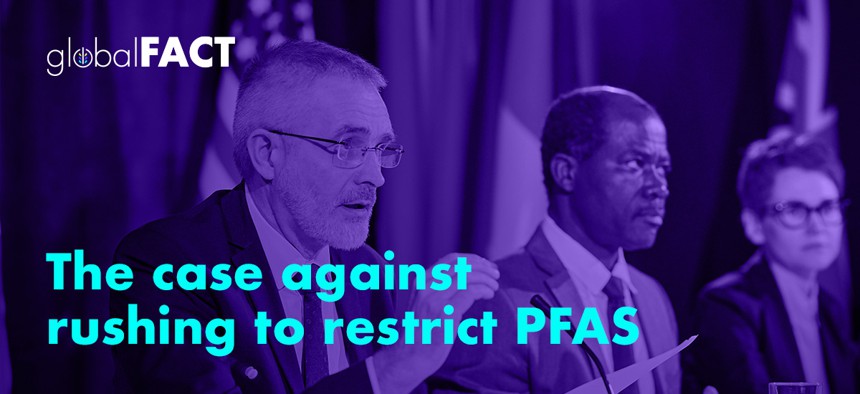sponsor content What's this?
The Case Against Rushing to Restrict PFAS

Presented by
globalFACT

By: Jordan Smith
Thoughtful and effective regulation depends on a clear understanding of that which is being regulated. Therein lies the challenge with PFAS.
For over a decade, scientists have been gathering information about the many thousands of per- and polyfluoroalkyl substances (PFAS). At the same time, policymakers across the country have been attempting to interpret this scientific information to inform policy at the state and federal levels in the U.S.
There is no universal definition for PFAS that is recommended for regulatory purposes. Even the Organization for Economic Cooperation and Development suggests that its definition should not be connected to decisions on how PFAS should be grouped in regulatory and voluntary actions. Despite the absence of a widely accepted definition, some governing bodies have developed regulations that are overly broad and inconsistently combine substances into groups based on chemical structures rather than on hazard properties or risks based on PFAS prevalence, usage, and health effects.
For example, Maine and Minnesota are pursuing broad bans on PFAS, despite the disparate chemical properties and lack of demonstrated alternatives. In contrast, the U.S. Environmental Protection Agency (EPA) and the State of Delaware are taking a more prescriptive approach to ensure that regulatory restrictions are focused on those PFAS that have been scientifically linked to causing harm. And in California, a proposal that would have required registration of all goods containing PFAS was vetoed based on concerns that utilizing a broad definition did not account for health and safety profiles or potential for exposure of individual PFAS compositions.
Regulating PFAS based on expansive definitions that lack agreement across the scientific community can result in a confusing patchwork of state laws throughout the country. As other jurisdictions consider PFAS regulations, it is critical that policymakers understand the unintended consequences of a one-size-fits-all classification.
PFAS are substances containing fluorine and carbon atoms, which are used in a wide range of applications. Various PFAS are used in pharmaceuticals, cell phones, medical devices, automotive EV applications, personal protective equipment, and other products critical for society.
One category impacted by an overly broad definition is fluorinated refrigerant products, also known as HFCs and HFOs, which are essential for ensuring food and cold chain safety and providing productive and comfortable work, study and living environments. HFCs and HFOs are already highly regulated by the EPA and are not commonly regarded as PFAS. They have a low global warming potential (GWP), do not persist in the environment, and do not bio-accumulate. HFCs and HFOs have been reviewed and approved under the EPA’s Significant New Alternatives Policy. And, importantly, for many applications, there is no safe, energy-efficient, or cost-effective alternative to these essential cooling products.
What are the repercussions of an overly broad PFAS definition on the manufacturing of essential products? Would states such as Maine and Minnesota continue to use essential products containing PFAS even after the substances are banned?
If an overly broad definition is used, how will banning PFAS impact the integrity of medicines or the food cold chain that has refrigeration requirements?
What is even more troubling is that state policymakers appear to be placing their hopes on the development of substitute substances that can replace PFAS in the near-term. Although the scientific community is making progress on alternative substances, it is a long and complex road before any of these substitutes can be widely implemented.
To be clear, it is vital to carefully assess the health and environmental impacts of individual substances through a scientific and risk-based approach. While it makes sense to pursue alternatives to PFAS with proven adverse effects, it is critical to recognize that not all substances included in overly broad definitions of PFAS share the same hazard and risk profiles.
Banning PFAS substances without scientific justification can have far-reaching consequences and affect all types of applications. It presents challenges to meeting carbon neutrality goals and risks unintended consequences of inadequate substitutions. We must be pragmatic about how PFAS are defined and regulated to avoid broad-brush bans in a piecemeal fashion.
This content is made possible by our sponsor globalFACT; it is not written by and does not necessarily reflect the views of Route Fifty’s editorial staff.
NEXT STORY: 5 steps to tackle runaway deferred maintenance for government facilities





